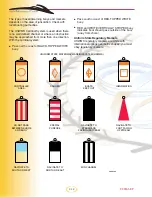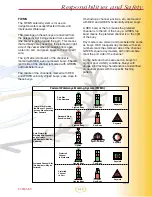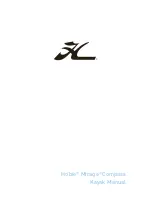
2-10
General Safety
Before each outing you should check all safety
equipment, such as fire extinguishers, PFDs,
flares, distress flags, flashlights, engine stop
switch, etc. They should be operable, in good
condition, readily visible, and easily accessed.
Check local weather reports before casting off; do
not leave the dock area when strong winds and
electrical storms are in the area or predicted to be
in the area.
Tell someone your travel plans and leave them a
float plan. A float plan makes the job of search
and rescue much easier for authorities. A float
plan template can be found in the back of this
manual.
Seating
Keep your passengers seated in seats. The boat’s
bow, gunwale, transom platform and seat backs
are not intended for use as seats while underway.
Handholds
!
WARNING
Passengers should use handholds
whenever the boat is underway.
!
WARNING
Do not allow passengers to sit in the two
stern sun lounges when the boat is
underway.
!
WARNING
• Read and understand this manual and
the propulsion unit manual, and be sure
that you understand all controls and
operating instructions before
attempting to operate the boat.
Improper operation can be extremely
hazardous.
• Be in control of your boat. Do not
operate your boat under the influence of
alcohol or other drugs.
Handholds are provided for your passengers’
safety. Be sure your passengers use the
handholds whenever the boat is underway. Failure
to use handholds could result in a man overboard
situation or personal injury.
Capacity
Know the weight capacity of your boat. Do not
overload your boat. Overloading of passengers,
personal equipment and supplies could result in
an accident, especially in rough waters.
Loading
Be sure that passengers, personal equipment and
supplies are in their proper location before
operating the boat. It does not necessarily mean
you can carry a passenger for every seat. Keep
personal equipment and supplies to an “as
needed” basis. Maintain a balanced load (front to
back and side to side) at all times.
Operating Conditions
Every waterway poses hazards that you should
avoid, such as shallow water, tree stumps and
sand bars. Ask local boaters for information and
consult a marine chart when boating on unfamiliar
waters. As the operator of the boat, you should try
to avoid all hazards, known and unknown. The
following information does not contain all possible
water hazards.
Operating in shallow water presents a number of
hazards. Mud, sand, weeds and debris can foul a
propulsion unit propeller or its cooling water. If a
propulsion unit strikes an underwater object,
check the propulsion unit and boat for damage. If
a propulsion unit vibrates after striking an object, it
may indicate a damaged propeller.
Sand bars in narrow inlets are constantly shifting,
making it difficult to mark them with buoys. Tides
in coastal areas affect water levels producing
sand bars. Sometimes sand bars are indicated by
waves as they form into breakers when passing
over the sand bar. Refer to
Grounding
, in this
section, if you run aground on a sand bar.
The water level around a dam spillway is a
hazardous area. It is subject to rapid changes
caused by currents and turbulence. Keep clear of
the spillway areas below dams.
Summary of Contents for 360
Page 1: ...Owner s Manual ...
Page 36: ...2 22 ...
Page 74: ...3 38 ...
Page 108: ...5 14 ...
Page 111: ...6 3 SERVICE LOG Date Hour Reading Service Repairs Performed Checklist Forms and Index ...
Page 112: ...6 4 FUEL LOG Date Gallons Hours Gallons Hour Date Gallons Hours Gallons Hour ...
Page 118: ...6 10 ...
Page 119: ......
















































